One of the nice things about the modern wargaming ecosystem is that there are lots of options for purchasing terrain – the days where everything needed to be scratch built are long past us. There’s a wealth of plastic kits, MDF scenery and 3d printed/printable offerings out there, but today we’re still looking at something that’s breaking new ground – metal terrain.
Steel City Wargames are launching the Kickstarter for their Battlefield in a Bag product on 4th May, and they offered us a review copy to take a look at, which we happily agreed to. Does a new material allow this product to carve out a new niche? Let’s take a look.
Goonhammer was provided with a review copy of this product. Links to the Kickstarter in this article contain a referral code for tracking purposes only – Goonhammer will not receive any affiliate payments, directly or indirectly, if you use it. We provided feedback to the manufacturer during the review progress, and some product changes have resulted from this.
The Kickstarter can be found here.
The Product
First Impressions
The goal of the Steel City terrain is to provide a highly portable table’s worth of terrain for 40K and Historicals, and on that front the first impressions are good. The terrain comes in a custom bag, and I was honestly taken aback when I got a first look at it, because it’s pleasingly compact (under 12″ in all dimensions).
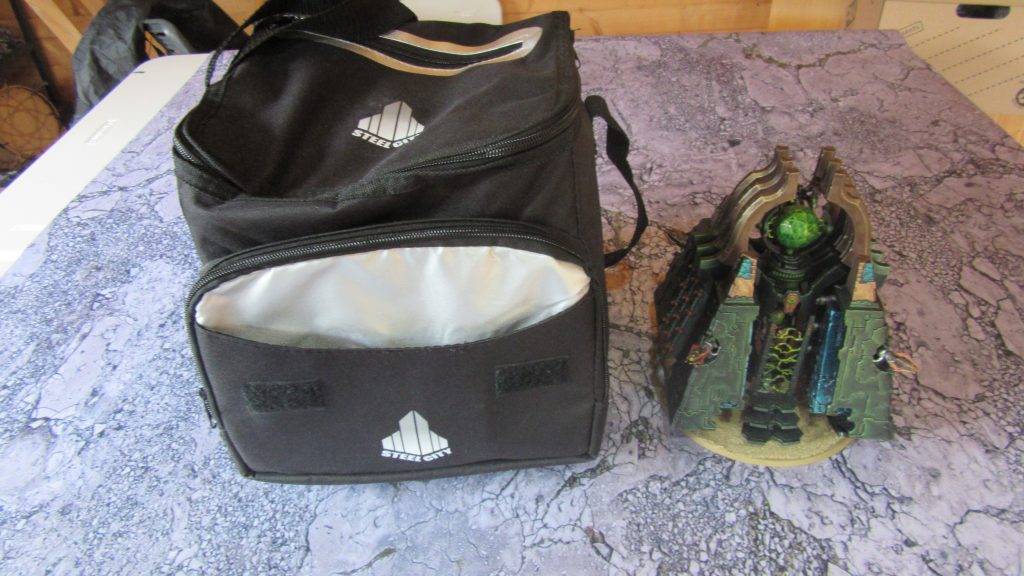
You genuinely could throw this over your shoulder to take to a friend’s house/store, and despite being metal, it’s not too heavy (I weighed it in the 3-3.5KG range).
Inside you find the terrain itself, which is made from laser-cut steel, and my second surprise was how thin it was. Because steel is (famously) sturdy you can go a lot thinner than with MDF and still have it be stable enough for use.
You get the following pieces, which correspond to the set you need for UKTC maps plus some additional tank traps.
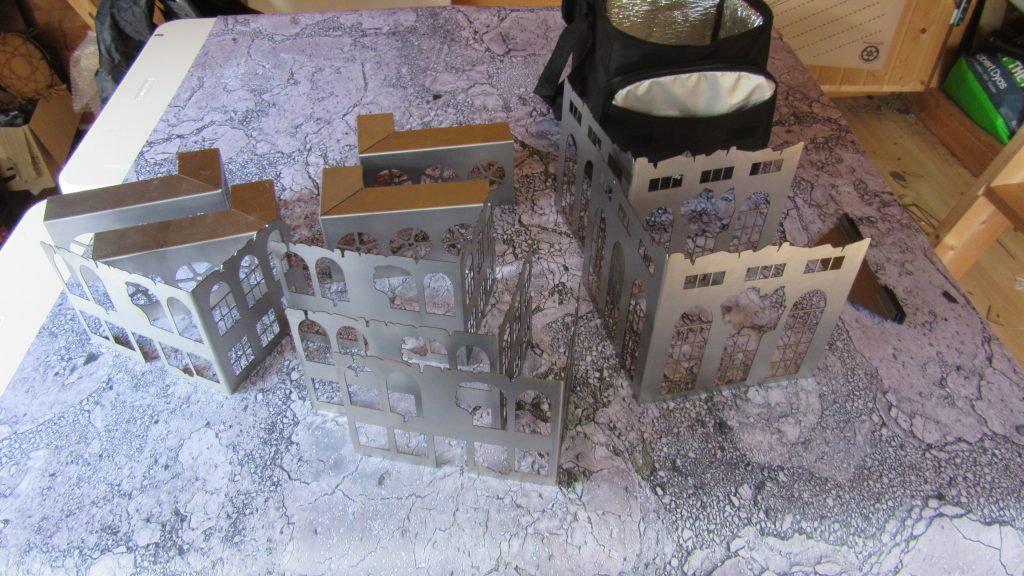
Note: The review copy we received had an issue where the “medium” ruins were the wrong way round for UKTC boards. We’ve fed this back, and been told it will be fixed in the production run!
The largest ruins also have an additional clever addition, which is magnetisable floors, allowing you to provide some elevation. This is super cool, and a very clever use of the material.
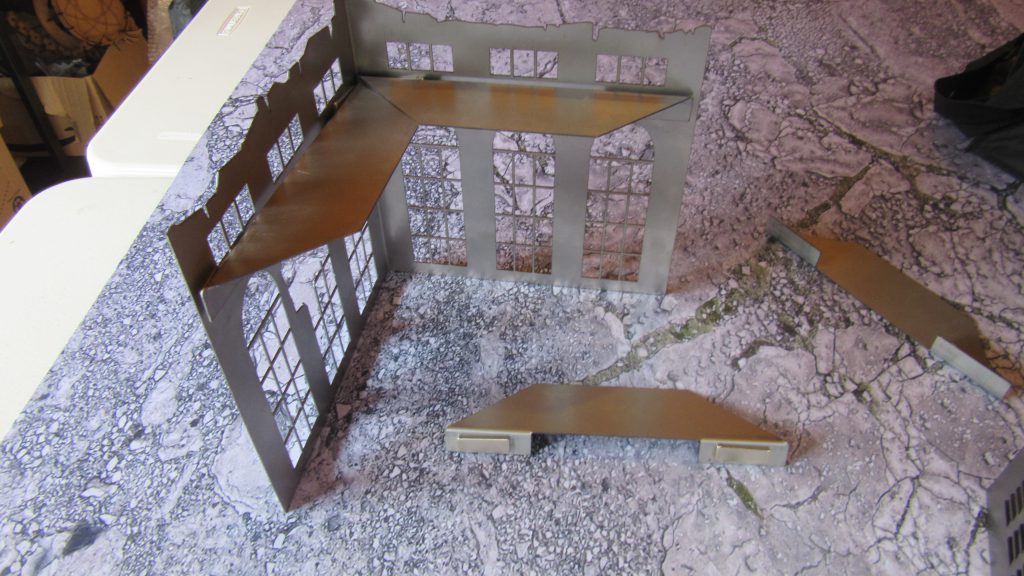
On the Table
Once we’d put these on the table to try a game in them, my initial feeling was that I really like the look of the small ruins, and would happily throw them on a table for any kind of game, but find the look of the big and medium ruins to be a bit “weightless”.
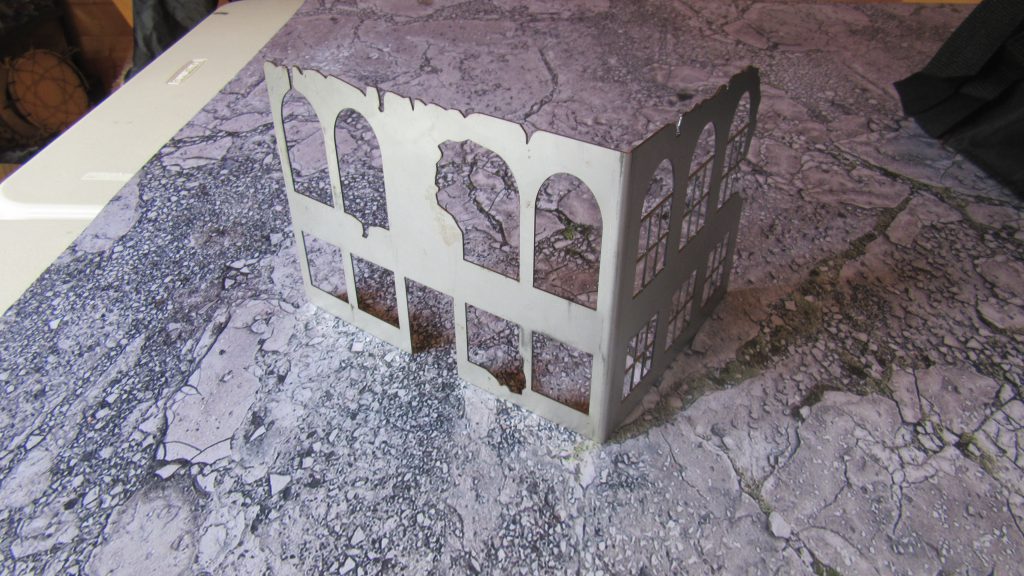
They’re so thin and have so many gaps in them that it’s going to be a bit immersion breaking to use them for narrative play without some customisation (some ideas on that later), aiming these squarely at the competitive market. That is obviously the goal, and you wouldn’t achieve the portability without it, but if I was putting together a narrative or high-production value competitive event, I’d only be interested in the small corners and tank traps. The small corners are definitely my favourite piece in the set – the roof gives them a nice amount of solidity, and the design gives a good amount of visual interest.

We did find, as we played out a warmup game for the Oxford GT on them, that for competitive practice the ability to see through the bigger pieces is surprisingly helpful as it makes it easier to keep track of where everything is on the table, helping you work through options in the game state.
On the flip side, it would have been nice to see the magnetic floor idea extended to add some base areas to the ruins, particularly the medium ones where on UKTC the base isn’t “squared off” with the terrain. In general, there’s a lot more you could do with the magnet concept, and I hope that some add-ons get made in the future to address this.
Other Thoughts
Two more things come out of the way this product is made, one good, one less so (though we’ve had a good response to feedback here). The “good” is that this will store in bulk better than any other terrain set out there, and it’s not close. You’d probably get two of these in one bag if you got creative (though that’s caveated with the next point), but if you instead stored lots of sets together I think you’d trivially get a 16-player RTT’s worth of terrain into a 35L Really Useful Box (god’s own storage solution), and that might be a conservative estimate.
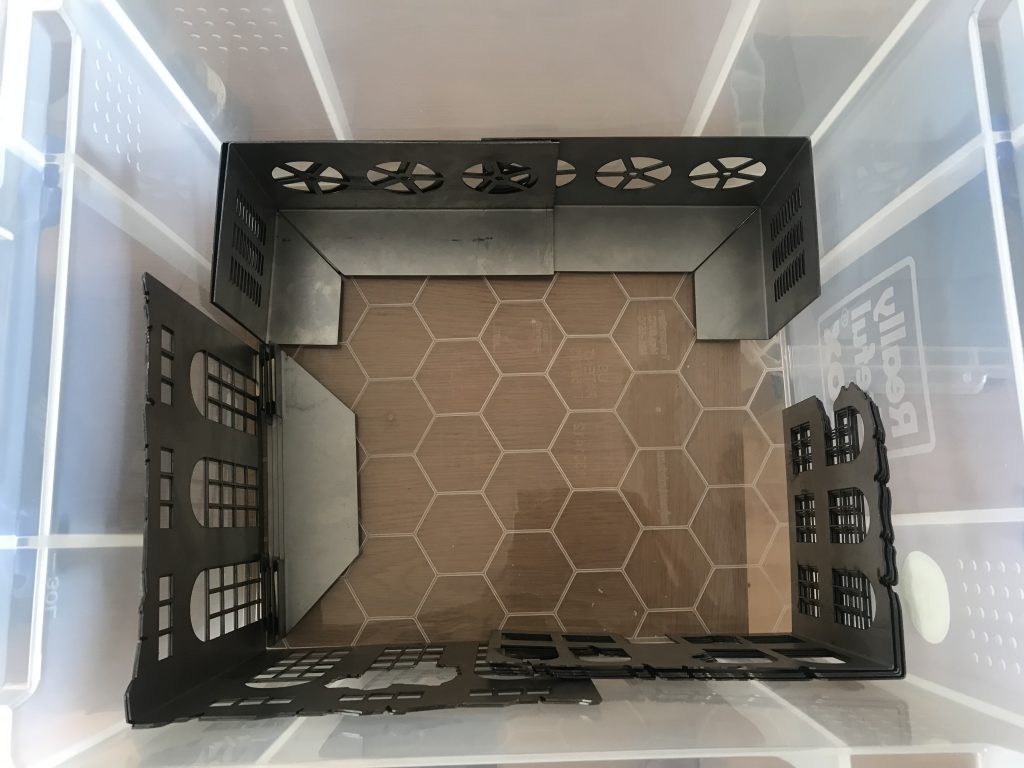
As Goonhammer we have the luxury of an income stream that lets us rent storage space to keep our stacks of bulky terrain in, but if you’re a new TO starting out the storage density (and thus portability) of this makes storage a real consideration, and similar factors apply to clubs that want to keep some competitive terrain on hand.
That’s the good bit – the more negative is that the corners of the review copy were surprisingly sharp. Some effort had gone into mitigating this by breaking up the tops of the ruins with some detailing, but the bottom corners are still sharp, and I managed to tear the inner lining of the storage bag (between the main and front pockets) while packing it away (though the outer layer of the back was fine).
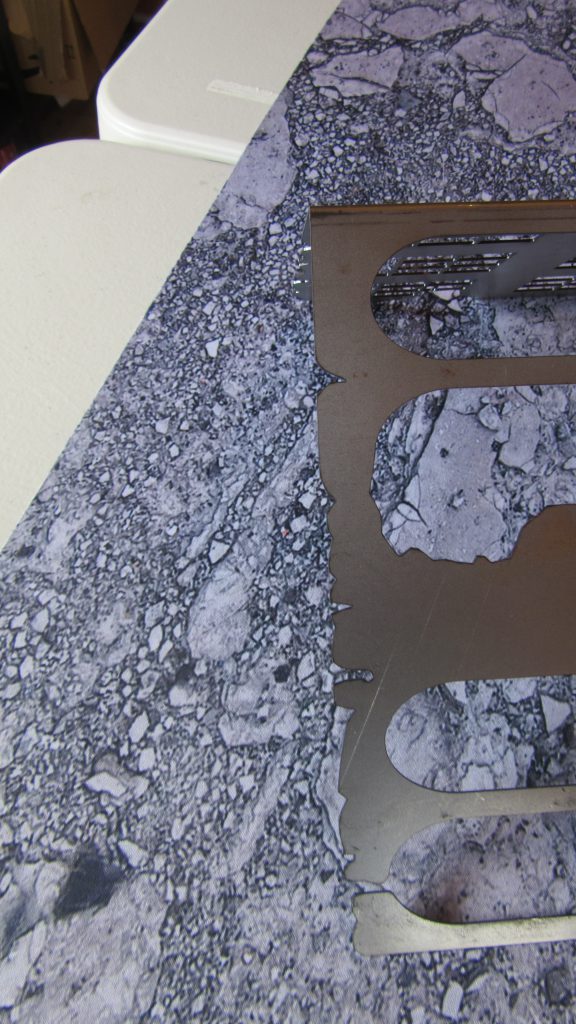
The mitigation in the design means this isn’t a dealbreaker (and it’s again less of a problem for the smaller pieces), but it might be a concern if you’re expecting younger kids to play games with it (e.g. at a school club). We fed this back to the manufacturer, and they are planning to update the final version to round off the bottom corners as well, and we have been told that the Kickstarter will include before/after images.
Customisation
With any sort of terrain that starts as bare material I’m going to be looking at how easy it is to customise it, and there are a few ways you can approach this here.
First up is obviously painting, and I think this is one of the places where the metal has a bit of a disadvantage over MDF – it starts out looking nicer, but because it doesn’t have any depth you can’t get as much done with a prime and then a highlight spray/wash with dip. I’d probably hit this with an uneven spray with an accent colour of metallic paint, but this isn’t going to get this all the way to something you’d be happy to use for narrative play.
However, after wracking my brains a bit, I came up with a way to turn the material to my advantage – because as the floor pieces demonstrate, this stuff is magnetic. Years and years ago I brought a pack of magnetic tape (https://www.hobbycraft.co.uk/magnetic-tape-12.7mm-x-8m/6640261000.html) from Hobbycraft, and haven’t found any use for it on any of my models or projects. Here, at last, it came in handy. As a proof-of-concept, I cut out a small piece of plasticard, backed it with some magnetic tape and stuck some waterslide transfers on it, and voila, the customisation begins:
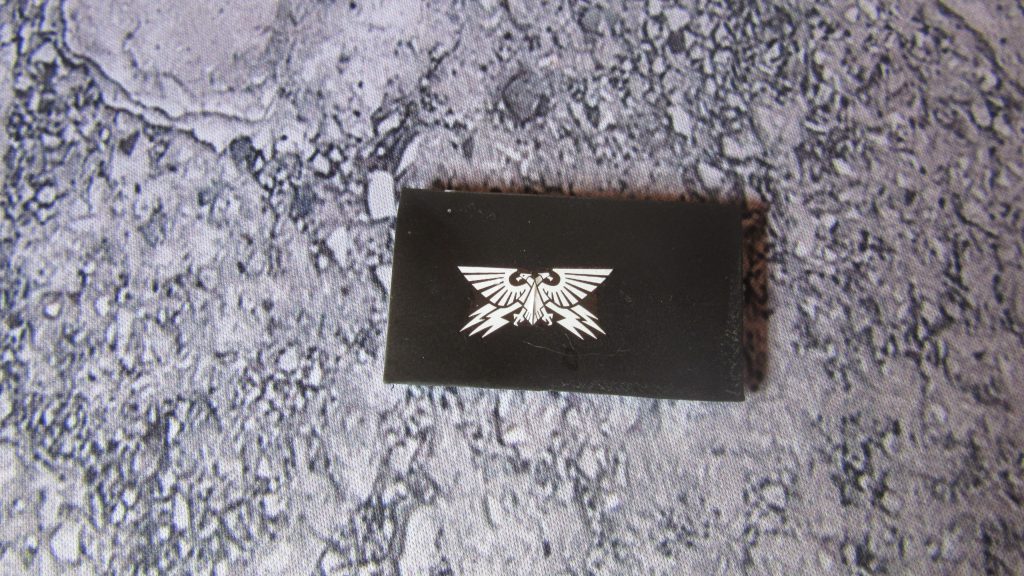


Obviously that’s a prototype, but this is definitely the way I’d go if I wanted to use this for narrative play, essentially creating modular, magnetic cladding that you can arrange to your heart’s content, without making any permanent changes that compromise the portability of the pieces. I used a transfer here, but airbrush stencils would work really well too, and you could probably make this very Orky just by cutting out appropriate jagged pieces of plasticard and spraying them a rusty metal colour. Being able to do this makes me much happier to recommend the product for a wider audience, and it’s honestly quite a nice way to give yourself a sturdy “frame” to work with that you can then customize on top. I found the ability to do this genuinely delightful, and I’ve fed back the suggestion to the creator that they explore this for Kickstarter add-ons or future expansions.

Finally, basing. TheChirurgeon assures me that the Old World modular movement trays are what you want here (or a third-party equivalent) and I agree – the little ridges that border these are going to be vital for creating enough of a contact point for this to stick if you want something permanent, as the ruins are so thin that just glueing them down isn’t going to hold. For the medium ones, the size is also pretty much dead-on that you can put them flush next to a large GW perspex square or area mat (like the Bandua ones we use).
Price and Final Thoughts
The battlefield-in-a-bag set comes in at £199, which firmly puts it into the premium product range. Material costs are obviously a significant driver here, so this is understandable, and the lack of any assembly requirement to get gaming is an upside (even the speediest MDF terrain is a solid few hours to build a table, more if you’re not practiced). However, you can comfortably get an MDF table’s worth of terrain for 40-60% of this (depending on where you aim on the quality spectrum), so if you’re price-conscious this probably isn’t for you unless the portability and space-saving aspects are particularly important for you.
Taking that and everything else into account, this product might be for you if:
- You’re a competitive player and want a portable terrain set to take to friend’s houses or stores which don’t have enough terrain – there really isn’t anything else that does this quite as well.
- You’re a TO (particularly in the UK since it’s UKTC format) or club for whom storage and transportation space are at a premium.
- Being usable straight out of the box is important for you.
Key downsides would be if:
- The price is too high.
- You want something that’s beautiful out of the box – this is definitely function over form, though it is nicer than bare MDF, in my opinion.
- You want to run high production value events (unless you’re going to customise it heavily).
Overall – this product isn’t the be-all and end-all of terrain solutions, but it definitely does target it’s chosen niche very effectively, so if the pros above are piquing your interest, consider backing the Kickstarter.
Thanks again to Steel City Wargaming for the review copy!


